#theological virtue
Explore tagged Tumblr posts
Text
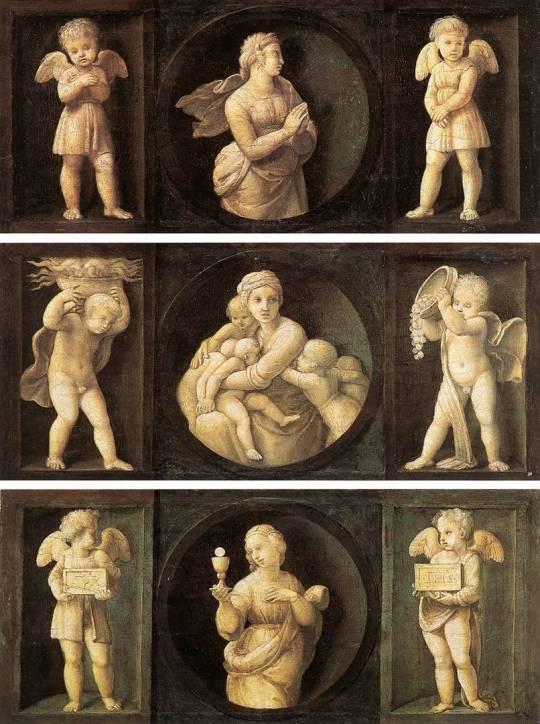
Raphael - Theological Virtues. 1507
201 notes
·
View notes
Text
General Audience, May 1st. 2024
Summary of the Holy Father's words
Dear brothers and sisters: In our continuing catechesis on the theological virtues, which unite us to God and strengthen the moral virtues, we now turn to faith. The Catechism states that by faith we believe in God and all that God has revealed to us, and freely commit our entire self to him (cf. No. 1814). Throughout the Scriptures, we encounter poignant examples of this manifested in the lives of such individuals as Abraham, Moses and the Blessed Virgin Mary, who embarked on uncharted paths fraught with perils entrusting themselves completely to God. Yet even among believers, there are times when faith can falter and fear takes hold. Let us remember that faith is a gift, a gift that must be asked for with confidence in the power of God’s grace to give stability and strength to our lives. Like the disciples in the boat, buffeted by the storm on the lake, let us turn to Jesus each day and beg him: “Lord, increase our faith!” (Lk 17:5)
5 notes
·
View notes
Text
I never said he was political. What I said was "His followers then went on to live in voluntary communism", which is an objective fact of the Jerusalem centered community of the Early Jesus Movement.
The definition of communism (lowercase c): "a form of economic organization in which private goods are held in common by a community"
Twice in the Book of Acts does it say that the "And the multitude of those who believed were of one heart and being; and not one was saying that anything belonging to them was their own, but all things were common property to them. And with great power the apostles were giving testimony to the resurrection of the Lord Jesus, and abundant grace was upon them all. For there was not a needy person among them, for all who were owners of land or houses would sell them and bring the prices of the things being sold and lay them at the apostles’ feet, and they would be distributed to each to the extent that any had need."
Now, one of my bible commentaries (NIV) would say this isn't communism because:
"the sharing was voluntary" This doesn't make it not communism - a form of economic organization in which private goods are held in common by a community. That is literally what this is.
"it didn't involve all private property, but only as much as was needed" Scripture doesn't say that, nor are their any hints or hyperlinks that suggest such. We could reason that this is an example of exaggeration to make a point (see: Solomon's wealth) but I don't really think that's necessary. It is quite possible that in fact most of the people in the Jerusalem district of the Early Jesus Movement decided that the best way to live at the teachings and message of Jesus, the Torah and the prophets, was to live together as a communal group.
"it was not a membership requirement to be a part of the church" Ofc not, which is what makes it better! This wasn't motivated by any political or economic theory, any more than Jesus' life was motivated by political philosophy: it was koinonia rooted by agape - other centered, life giving love from me to you that causes me to lay down my life for you.
(Side note: I do not think it's a coincidence that Jacob/James who was leader of the Jerusalem church wrote the way he did on wealth. It is clear that there was some sort of issue in the socio-economic reality of Jerusalem, likely centered in oppression of employees and heavy taxes as well as ethnic differences, that the early Christians were NOT a fan of).
Also all of this makes perfect sense tho. You can say whatever you want about Jesus not being political (and I won't address that because we'll need to define that word and this post is long enough) but there is something undeniable: Jesus, and also the rest of his Galilean disciples, were not a fan of people who lived comfortably on their wealth while other's went hungry. Which is incredibly uncomfortable for me (it actually put the fear of God in me a few weeks ago) but it is what it is.
Now. I am not a communist and never have been, not because the scriptures ever condemn communism, but because the human heart is wicked above all things and is irreversibly sick without the Spirit giving them a new one (see: the entire Tanakh). I do think there is a reason why when the government decides to implement communism it ends in dictatorship. Instead, I've been looking into Catholic Social Teaching and find Distributism to be interesting.
That said, I think local Christian communities can and should absolutely consider whether they wish to live communally together and what that would look like for them. And no matter what all Christians must change the way they look at their possessions.
Other Christians: Yeah I’m a Christian, but don’t worry, I’m normal.
Meanwhile, Christian Tumblr: I worship a triune God who emptied themself to become a human. He was born a poor teenager and grew up in poverty and at risk of homelessness. He was fully God and fully Human. He taught and lived in radical indiscriminate self giving love and subversive peaceful resistance of oppression. He fought the cause of the widow, orphan, immigrant, poor, and oppressed. He loved the sinner so much they left their sin and followed him, and reconciled both the government allying capitalist and the rebel freedom fighter to harmony in himself. He invites us to take his prescience into ourselves by eating his flesh and drinking his blood. My God then enthroned himself as the exalted king of the world by dying the death of a cursed blaspheming slave. He then rose from the dead and decided his first witnesses would be women, whose witness is worthless in court. His followers then went on to live in voluntary communism, to advocate radical generosity, to destroy ethnic barriers, to elevate the inherent humanity of women and the enslaved, to self identify as exiled and enslaved refugees and pilgrims, to equate God with Love, to diagnose the government as a necessary evil worth responding to with equal parts submission and resistance, and to make the preposterous claim that we conquer the world by giving our lives in self sacrificing love. In my faith, normalcy is heresy.
#anyway#capitalism is idolatry (see: treating profit as god and productivity as the highest virtue at the expense of fellow humans and environment)#the church is a socio-political institution#(“politikos” is the terms to which we all commit to live together)#a multi-ethnic covenant people bound by their allegience to jesus ans his love for them that is so radically different value system#creating peace and justice in radical ways#so to say jesus is “not political” is wrong from an etymological standpoint#as well as historical#the church is a political institution and thus should create an economic reality#on both a small scale (christians should live in modesty and radical generosity with their neighbors and the marginalized)#and on a larger scale (see: distributism)#christianity is very much political. to the point where if anyone was to ever ask me what my political stance was on anything#my answer would be “jesus is lord”. the same answer as the apostles. this is both a theological claim and a political one
768 notes
·
View notes
Text
Humility - Virtues at Work
Waterwheel at Onden, 1830-1834 by Katsushika Hokusai “A virtue by which a man knowing himself as he truly is, abases himself.” St. Bernard What is Humility? Humility is a virtue that tempers our desires for good things, so that we aim at the right ends with noble and pure motivation shorn of egoism and self-seeking. It comes from the root word ‘humus’, which means to be low to the ground. The…

View On WordPress
0 notes
Text
مذہبی فضائل پیکیج
______________________________________________________________ ہمیں بپتسمہ کی رسم پر مذہبی فضیلتیں، ای��ان، امید اور خیرات ملتی ہیں۔ نیچے دیے گئے لنکس پر کلک کریں، نزولی ترتیب میں، ان کے متعلقہ مضامین کی بازیافت کے لیے۔ مذہبی فضائل ایمان امید صدقہ ______________________________________________________________
View On WordPress
0 notes
Text
Bankruptcy is very, very good

On THURSDAY (June 20) I'm live onstage in LOS ANGELES for a recording of the GO FACT YOURSELF podcast. On FRIDAY (June 21) I'm doing an ONLINE READING for the LOCUS AWARDS at 16hPT. On SATURDAY (June 22) I'll be in OAKLAND, CA for a panel and a keynote at the LOCUS AWARDS.

There's a truly comforting sociopathy snuggled inside capitalism ideology: if markets are systems for identifying and rewarding virtue, ability and value, then anyone who's failing in the system is actually unworthy, not unlucky; and that means the winners are not just lucky (and certainly not merely selfish), but actually the best and they owe nothing to their social inferiors apart from what their own charitable impulses dictate.
It's an economic wrapper around the old theological doctrine of providence, whereby God shows you whom he favors by giving them wealth and station, and marks out the wicked by miring them in poverty. And like the religious belief in providence, the capitalist belief in meritocracy is essential to resolving cognitive dissonance: it lets the fed winners feel morally justified in stepping over the starving losers.
The debate over merit and luck has been with us for millennia, and even the hereditary absolute monarchs of the Bronze Age had to find a way to resolve it. For the rulers of antiquity, the way to square that circle was jubilee.
Bronze Age jubilees were periodic celebrations in which all debts were canceled. Different kingdoms had different schedules for jubilees, but imagine some mix of "every x years" and "every time a new ruler takes the throne" and "every time something really portentous happens." To modern sensibilities, the idea that we would simply wipe away all debts every now and again is almost inconceivable. Why would any society practice jubilee? More importantly, how could a ruler get the wealthy creditor class to countenance a jubilee, rather than seeking a revolutionary overthrow?
The best answers to this question can be found in the scholarship of historian Michael Hudson, who has written extensively on the subject. Hudson doesn't just write for a scholarly audience, he's also a fantastic communicator with a real commitment to bringing his research to lay audiences:
https://michael-hudson.com/
Hudson's most famous saying is "debts that can't be paid, won't be paid." It's in this dense little nugget that we can find the answer the the riddle of jubilee:
https://pluralistic.net/2021/09/29/jubilance/#debt
Let's start with a simple model of debt and credit in an agricultural society. In agricultural societies, everything exists downstream of farming, which is the core activity of the civilization. If the farmers succeed, everyone can eat, and that means they can do all the other things, all the not-farming work of your society.
To farm successfully, you need credit. Farmers enter the growing season in need of inputs: seed, fertilizer, labor; they need still more labor during the harvest. Without some way to acquire these inputs before the farmer has a crop that can pay for them, there can be no crop.
No wonder, then, that the earliest "money" we have a record of is ancient Babylonian credit ledgers that record the debts of farmers who borrow against the next crop to pay for the materials and labor they'll need to grow it. Debt, not barter, is the true origin of money. The fairy tale that coin money arose spontaneously to help bartering marketgoers facilitate trade has no historical evidence, while Babylonian ledgers can be seen in person in museums all over the world.
Farming requires an enormous amount of skill, but even the most skillful farmer is a prisoner of luck. No matter how good you are at farming, no matter how hard you work, no matter how carefully you plan, you can still lose a harvest to blight, drought, storms or vermin.
So over time, every farmer loses a crop. When that happens, the farmer can't pay off their debts and must roll them over and pay them off with future harvests. That means that over time, the share of each harvest the farmer has claim to goes down. Thanks to compounding interest, no bumper crop can erase the debts of the bad harvests.
That means that, over time, "farmer" becomes a synonym for "debtor." Farmers' productive output is increasingly claimed by the rich and powerful. No matter how badly everyone needs food, the whims of the hereditary creditor class come to dictate the country's agricultural priorities. More ornamental flowers for the tables of the wealthy, fewer staple crops for the masses. "Creditor" and "debtor" no longer describe economic relations – they become hereditary castes.
That's where jubilee comes in. Without some way to interrupt this cycle of spiraling debt, society becomes so destabilized that the system collapses:
https://pluralistic.net/2022/07/08/jubilant/#construire-des-passerelles
In other words: debts that can't be paid, won't be paid. Either you wipe away the farmers' debts to the creditor class, or your society collapses, and with it, the political relations that made those debts payable.
Jubilee is long gone, but that doesn't mean that debts that can't be paid will get paid. Modern society has filled the jubilee gap with bankruptcy, a legal process for shriving a debtor of their debts.
Bankruptcy takes many forms. The most important split in bankruptcy types is between elite bankruptcy and the bankruptcy of the common person. The limited liability company was created to allow people with money to pool their funds to back corporations without being responsible for their debts. This "capital formation" is considered "efficient" by economists because it creates the backing for big, ambitious projects, from colonizing and extracting the wealth of distant lands (Hudson's Bay Company) to spinning up global manufacturing supply chains (Apple).
Limited liability means that companies can take on debt without exposing their investors to risks beyond their capital stake. If you buy $1,000 worth of Apple stock, that's all you stand to lose if Apple makes bad decisions. Apple may rack up billions in liabilities – say, by abusing its subcontractor workforce – but Apple's owners aren't on the hook for it.
Economists like this because it means that you can invest in Apple without having to be privy to its daily management decisions, which means that Apple can accumulate huge pools of capital, "lever them up" by borrowing even more, and then put all that money to work on R&D, product development, marketing, and, of course, "incentives" for key employees and managers.
But limited liability also does a lot of work in the political sphere. Once an individual crosses a certain wealth threshold, they become an LLC. Accountants and wealth managers and financial planners insist on this. For freelancers and other sole practitioners, the benefits of forming an LLC are modest – a few more tax write-offs and the ability to get a business credit-card with slightly superior perks.
But for the truly wealthy, transforming yourself into the "natural person" at the center of a vast pool of LLCs is essential because it allows you to accumulate and shed debts. You can secretly own rental properties and abuse your tenants, accumulate vast liabilities as local authorities pile fine upon fine, and then simply dispose of the LLC and its debts. Plan this gambit carefully enough and the debtor LLC will have no assets in its bankruptcy estate apart from the crumbling apartment building, and its most senior secured creditor will be another of your LLCs. This lets the slumlord move an apartment block from one pocket to another, leaving the debt behind.
For the corporate person, shedding debts through bankruptcy is an honorable practice. Far from being a source of shame, the well-timed, well-structured bankruptcy is just evidence of financial acumen. Think of the private equity looters who buy a company by borrowing against it, pay themselves a huge "special dividend," then wipe away the debt by taking the company bankrupt (which also lets them shed obligations to suppliers, workers, and especially, retirees and their pensions). As Trump (a serial bankrupt who has stiffed legions of contractors and creditors) would say, "That makes me smart."
The apotheosis of elite bankruptcy is found in massive corporate bankruptcies, in which a corporation kills and maims huge numbers of people, then maneuvers to get its case heard in one of three US federal courtrooms where specialist judges rubber-stamp "involuntary third-party releases" that wipe out the company's obligations to it victims for pennies on the dollar, while the company gets to keep billions:
https://pluralistic.net/2021/07/29/impunity-corrodes/#morally-bankrupt
This process was so flagrantly abused by companies like Johnson & Johnson (which spent years knowingly advising women to dust their vulvas with asbestos-tainted talc, creating an epidemic of grotesque and lethal genital cancers) that it is finally generating some scrutiny and pushback:
https://pluralistic.net/2023/02/01/j-and-j-jk/#risible-gambit
But the precarious state of elite bankruptcies has more to do with the personal corruption of the small cabal of judges who run the system than public outrage over their rulings; like that one judge in Texas who was secretly fucking the lawyer whose clients he was also handing hundreds of millions of dollars to:
https://pluralistic.net/2023/10/16/texas-two-step/#david-jones
Certainly, we don't hear much about the "moral hazard" of allowing the Sackler opioid family to keep as much as ten billion dollars in the family's offshore accounts while walking away from the victims of their drug-pushing empire, no matter what bizarre tricks they deploy in pulling off the stunt:
https://pluralistic.net/2023/08/11/justice-delayed/#justice-redeemed
But when it comes to canceling the debts of normal people, the "moral hazard" is front and center. If you're a person who borrowed $79k in student loans, paid back $190k and still owe $236k, we can't cancel your debt, because of the message that would send to other people who want to (checks notes) get an education:
https://pluralistic.net/2020/12/04/kawaski-trawick/#strike-debt
The anti-jubilee side also wants us to think of the poor creditors: who would loan money to the next generation of students if student debt cancellation was a possibility? Of course, these are federally guaranteed loans, risk-free, free money for people who already have money, a kind of UBI for the people who need it least. The idea that this credit pool would dry up if you were limited to only collecting the debts that can be paid – rather than insisting that debts that can't be paid still be paid – elevates the hereditary creditor class to a kind of fragile, easily frightened, endangered species.
But the most powerful arguments against bankruptcy are rooted in the idea of providence. In an efficient market, anyone who goes bankrupt was necessarily reckless. They were entrusted with credit they weren't entitled to, because they lacked the intrinsic merit that would let them manage that credit wisely. Letting them walk away from their debts means that they will never learn from their mistakes, and that their fellow born-to-be-poors will learn the wrong thing from those debts: that there's an easy life in borrowing, spending, and discharging your debts in bankruptcy.
As it happens, this is an empirically testable proposition. If this view of personal bankruptcy as a personal failure is correct, then people who go bankrupt and live to borrow again should end up bankrupt again, too. On the other hand, if we accept the jubilee view – that debt is the result of accumulated misfortunes, often including the misfortune of birth into poor station – then bankruptcy represents a second chance with an opportunity to dodge misfortune.
In a new study from IZA Institute of Labor Economics's Gustaf Bruze, Alexander Kjær Hilsløv and Jonas Maibom, we get just such an empirical analysis. It's called "The Long-Run Effects of Individual Debt Relief," and it examines the lives of people for a full quarter-century after a bankruptcy:
https://docs.iza.org/dp17047.pdf
The study follows Danish bankruptcies following the introduction of continental Europe's first modern bankruptcy system, which Denmark instituted in 1984. Prior to that, the Danes – like most of Europe – did not allow for a discharge of personal debt through bankruptcy. Instead, a debtor who went bankrupt would be expected to have about 20% of their lifetime wages garnished to pay back their creditors, until the debts were repaid or they died (whichever came first).
After 1984, Denmark bankruptcy system imported features of US/UK/Commonwealth bankruptcy, including the ability to restructure and discharge your debts. Not everyone is eligible for this kind of bankruptcy: there's a bureaucratic system that verifies that people seeking bankruptcy discharge don't have a lot of assets that could go to their creditors.
But for the (un)lucky people who qualify for bankruptcy discharges, there's a fascinating natural experiment in which the fortunes of people who see debt relief can be compared to bankrupt people who couldn't get their debts wiped out.
It turns out that the Bronze Age has a thing or two to teach us. Here's the headline finding: people who discharge their debts in bankruptcy experience "a large increase in earned income, employment, assets, real estate, secured debt, home ownership, and wealth that persists for more than 25 years after a court ruling."
After people are given the benefits of bankruptcy, they are less likely to rely on public benefits. They get better jobs. Their families live better lives. Their creditors get some of their money back (which is all they can realistically expect, since "debts that can't be paid, won't be paid").
As Jason Kilborn writes for Credit Slips, "the benefits of debt relief are not only substantial but robust, as debtors learn their lesson (if there was one to learn) about managing their finances, and they capitalize (literally) on their fresh start."
Score one for the luck-based theory of wealth, and minus one for the providential meritocracy hypothesis.
Americans should take note of these findings. After all, Danes are insulated from the leading American cause of bankruptcy: medical debts. In America, breaking a bone or getting cancer or even kidney stone can wipe out a lifetime of hard work, careful planning and prudential spending. The US refuses to seriously grapple with this problem. The best we can come up with is the (welcome, but tiny) step of banning credit bureaux from trashing your credit score because of your medical debt:
https://www.whitehouse.gov/briefing-room/statements-releases/2024/06/11/fact-sheet-vice-president-harris-announces-proposal-to-prohibit-medical-bills-from-being-included-on-credit-reports-and-calls-on-states-and-localities-to-take-further-actions-to-reduce-medical-debt/
Millennia ago, everyone understood that debts that can't be paid, won't be paid, and they created a system for discharging debts and freeing productive people from the tyranny of accumulated liabilities, to the benefit of all. Dismantling that system required us to invent an elaborate theological system and dress it up in economic language.

If you'd like an essay-formatted version of this post to read or share, here's a link to it on pluralistic.net, my surveillance-free, ad-free, tracker-free blog:
https://pluralistic.net/2024/06/17/lovilee-jubilee/#debts-that-cant-be-paid-wont-be-paid
#pluralistic#debt#debts that cant be paid wont be paid#jubilee#denmark#great danes#bankruptcy#second chances#scholarship#economics#iza#Gustaf Bruze#Alexander Kjær Hilsløv#Jonas Maibom#michael hudson
323 notes
·
View notes
Text
Weirdly enough, Nenya/the Ring of Water/Adamant is Galadriel's ring (despite her ring being so extremely white and starlike), which I guess works with the Mirror? Kind of?
But yeah, Vilya/the Ring of Air doesn't correspond with the water horses or with anything air- or sky-related for Elrond, as far as I can tell. Gandalf seems to be exception.
“There are many magic rings in this world, Bilbo Baggins, and none of them should be used lightly.”
-Gandalf the Grey, wielder of Narya the Ring of Fire and also coincidentally maker of the best magic fireworks in the world
#my personal theory is that the three rings correspond to the three theological virtues#but that doesn't explain why gandalf has so much more of an elemental bonus from his than we see with the other two#tolkien
15K notes
·
View notes
Note
I was in Rivain and got some ambient dialogue with Spite and a Qunari LoF. She called him a spirit of determination, wished him luck in all his endeavors, and Spite was like "YYYyYYYyYESS!" (he reminds me of Tim Curry)
Have you heard this dialogue? I took it at face value that if the spirit was being called Spite that meant he was a spirit of spite lol but determination can certainly come in a spiteful flavor after all. Anyways, what do you think?
oh yeah i haven’t heard this one, but i have heard isabela call spite a spirit of determination when she announces him (and lucanis as second billing lmao) if you bring them to the hall of valour fights (please bring all the companions to a hall of valour fight, her intros are so funny)
lucanis says back in the ossuary that what zara was summoning were spirits, who had no choice but to turn into demons under her “care”. spite probably was a spirit of determination, in the same way we’ve seen wisdom spirits turn to pride demons when mistreated. i guess it’s a classic thedas theological question how much you still consider him to be a spirit of determination after his transformation, and what we’re hearing from the lords of fortune is the rivaini stance on that
determination makes sense. if there’s any virtue lucanis can be safely said to embody in his life as a crow, it’s determination: the professionalism that demands he fulfil his contracts, and a lifetime of hard work and training towards being able to complete that purpose efficiently. i think we can assume zara was trying to “match” spirits with a host likely to share their qualities and the accompanying darker sides of those qualities, to best amplify them in what she was creating. and you can tell lucanis and spite are most unified when they have a clearly defined target ahead of them that they’re, well, determined to achieve
95 notes
·
View notes
Text
The Fuck's Up With Mammon?
Ok, so, in the grand history of Christian folklore, there are dozens of different ways that the society of Hell and its various demons can be structured. One of the most popular is The Seven Princes of Hell, which divides Hell between seven ruling demons, each of which represents the seven deadly sins (and is opposed by saints who represent the seven heavenly virtues). It's fun because it's got a solid theological theme and not too many working parts - seven is a more digestible number than nine or, like, however the fuck your sort out all the demons in the Lesser Key of Solomon, each of which has some arbitrary number of legions of demon soldiers under their command, and the deadly sins theme gives you a clear way to make each prince's domain stand out.
(Obviously I'm a bit biased here, since I used a modified version of the Seven Princes of Hell for my own story about demons, but still, I think the point stands.)
Now, who the seven princes of Hell are can differ. Binsfield, the guy who coined the name, lists them as follows:
Lucifer, Prince of Pride
Mammon, Prince of Greed
Asmodeus, Prince of Lust
Leviathan, Prince of Envy
Beelzebub, Prince of Gluttony
Satan, Prince of Wrath
Belphegor, Prince of Sloth
However, there are earlier versions of the seven princes that rearrange things. Beelzebub has been given the sin of Envy at times, Belphegor has been given gluttony, and both Belial and Abaddon/Apollyon have taken the role of prince of Sloth. With me so far?
Right, ok, so here's the thing: ALL of these demons have shit going on in folklore outside of their role as potential princes of Hell. Well, all except one. To wit:
Lucifer, despite being a translation error, quickly became the front-runner in the grand race of "Who is THE Devil in the Bible, i.e. the leader of Hell itself?" It helps that said translation error was made by King James in his version of the Bible, which, while a terrible translation, is an amazing piece of poetry in its own right and beloved by many Christians because of it. Notably, Lucifer is The Devil of Paradise Lost, which is up there with Dante's The Divine Comedy in being one of the most important and influential depictions of Hell of all time.
Beelzebub is one of the oldest demons in all of demonology, predating Christianity itself, and is pretty close to Lucifer in the race for "Who is THE Devil," with arguably a better claim to the position despite Lucifer being the more popular candidate for the role.
Satan gets kudos for being one of the few devils that's ACTUALLY named in the Bible... even if it's less a name in context and more a title akin to "prosecuting attorney." Because of that, he's arguably got the greatest claim to being The Devil, and in most works where a different devil gets the title, Satan is treated as one of his alternate titles anyway.
Asmodeus was set up in folklore to be The Devil, and has a pretty strong claim to the title because of that. He's also clearly what Dante based his description of the devil's physical appearance on, with his three different colored heads and all, and that gives him some major props.
Leviathan is also a rare demon who gets mentioned in the Bible, although in the Bible it's pretty clear he's not a demon but rather a big sea monster, and a lot of Christian folklore treats him as such instead of as a demon. So that's a pretty big "other thing going on" for him - sometimes he's not even a demon, but more of a godzilla.
Belphegor was mentioned in a good number of texts predating the concept of arranging demons by the seven deadly sins, and while he was mostly a minor demon (akin to most of the other residents of the Lesser Key of Solomon, like Shax or Marchosias or what have you), that's still something. Becoming a Prince of Hell gave him a greater claim to fame, but still, he had a career before it.
Abaddon/Apollyon is one of those demons whose name is ALSO a synonym for Hell itself, which is a pretty big deal. He can be a demon, or he can be hell, or he can be BOTH, like in the takes where Hell has a literal mouth to swallow sinners and is portrayed as kind of a living monster in its own right. He also got to be The Devil in Pilgrim's Progress, and that's pretty cool.
Belial is one of the absolute earliest demons, having been cast as The Devil in the Book of Enoch, which is kind of the O.G. Abrahamic demon story (as much as any written story could be the source of it, anyway). Thus, while Belial may not have the most popular claim to being The Devil, he arguably has the best claim to it, or at least the earliest. Also, Belial is just as often depicted as a lady demon as he is a male demon, which means Belial is the best candidate for a Princess of Hell.
But that leaves... Mammon. And as far as I can tell in all my research, Mammon's claim to fame is and has always been being the Demon of Greed. Like Lucifer, his existence is owed to a translation of the Bible personifying something that was not originally a person - "mammon" was just supposed to mean money and other material wealth, but then it became, well, Mammon, the demonic personification of Greed.
He's the demon who was made for his sin, rather than being given it after his creation. The only demon whose existence purely hinges on needing a personification of a sin, the only one who has no other shit going on. Lucifer, Beelzebub, Asmodeus, they all have rich histories as demons in folklore, but Mammon? He's just greed.
And that's weird to me. Were there no other, more popular demons who could embody the concept? How does Mammon feel having nothing else to him beyond his sin? It's kinda weird, right?
I've got no greater point to this, I just thought it'd be fun to share.
230 notes
·
View notes
Text
There is one moment in RoP that I keep forgetting to talk about but that I really enjoy and tickles my 'complex theological questions' interest to no end. It's when a wave knocks Cirdan's boat and dislodges the bag with the rings in them.
Because everything Durin III says is technically correct, the elves should not be in Middle Earth and their fading is a reality decreed by the powers that be. And if they had faded, if they had all left and taken Celebrimbor and Galadriel with them, likely all the horror that we are about to see come to pass would have been avoided. Sauron would not have been able to fulfill his plans to bind people to his will, that supernatural power would have been beyond him.
So, with that in mind, the general concensus is that the elves are acting counter to the will of Eru and the Valar, they are proud and rebellious and think too much of themselves (all of which is technically true) even though they have good intentions, and all of it will bring Middle-earth ruin and despair.
And yet! In the pivotal moment when an ancient elf of great virtue is about to seal the fate of elves forever and nobley refuse to play any part in the machinations or tools of evil, an Act Of God changes the whole course of history. Which is just a really neat nod to the other supposedly irrefutable fact of the cosmology of Arda; nothing happens that Eru has not already forseen or devised. The song was already sung and it is all just as he composed it, even those parts which Morgoth believed to be of his own devising.
Cirdan and Elrond did everything in their power to be as faithful and good and obeiscent to the west as possible, but in the end the darkness and despair is as the west wants it to be, and so they were never meant to succeed in the first place. It's both an extremely fun mental spiral to think about but also enraging and agonising enough to make you want to wail and rage at the heartless sky!!!! They never had any choice at all!!! They could never have saved anyone!!!!!!!
81 notes
·
View notes
Text


In mid-August, a three year-old lawsuit charging that environmentalist groups were religious extremists comparable to some of the more violent, intolerant, ultra-orthodox Islamic sects collapsed when the attorney failed to meet a re-filing deadline with the U.S. Supreme Court.
The suit had been brought against the Forest Guardians, the Superior Wilderness Action Network, and the U.S. Forest Service by the 125 companies that make up the Associated Contract Loggers (A.C.L.) of northern Minnesota. The loggers were asking for $600,000 in damages and permission to plunder timber from the Superior National Forest.
Lawyers for the A.C.L. argued that deep ecology was actually a religion, and so by extension, environmental groups that espoused its philosophies were cults, and by outlawing timber cutting on so-called “federal land,” the Forest Service was favoring a particular set of religious doctrines and was therefore violating the guarantee of neutrality in matters of religion purportedly vouchsafed in the U.S. Constitution.
According to theological scholars at the logging company syndicate like former executive director, Larry Jones, Deep Ecology is an “earth-centered religion,” a “belief system” that holds that “trees and Man [sic] are equal.” Anti-logging activists who extol the virtues of forested spaces over industry profit and environmental degradation are spiritual zealots, and the government functionaries who are swayed by their proselytizing may turn out to be fanatical closet druids themselves.
Stephen Young, the A.C.L. lawyer and a former Republican Party senatorial candidate, explained his legal action on such esteemed venues as Rush Limbaugh’s radio show by saying that clear-cutting in national forests had been restricted by the Forest Service for no reason other than reverebce for some fringe New Age religion.
A U.S. District Court judge in Minnesota dismissed the case as “frivolous” in February 2000, but the A.C.L. petitioned the Supreme Court last year after reports that Wahabi Islamic extremists were responsible for the blitzkrieg attacks on the World Trade Center and the Pentagon.
“The doctrine of Deep Ecology is the very worldview that gave rise to eco-terrorism. We feel that after the events of September 11, it’s an obligation of the Supreme Court to keep religious fanaticism in check,” Young said. “Just as devout faith in the literal words of various Hadith of Mohammad gave the Taliban license to impose through state power harsh conditions on the women of Afghanistan, so Deep Ecology gives license to its adherents to take extreme actions against those who would live by different beliefs.”
Perhaps the less said about this sleazy episode the better, which is just as well, since it is so hard to get a firm analytic grasp on it because it is sad and sick on so many different levels. For instance, likening the plight of women in Afghanistan to that of lumber barons in northern Minnesota is staggering in its shamelessness, as it has been my experience that women living near industrial logging camps are subjected to at least the same sort of abuse, derision, and masculinist domination as women who had been living in Taliban-controlled Kandahar.
And we all know that if the U.S. government was serious about keeping homicidal religious terrorism in check, then John Ashcroft and the Army of God anti-abortionists would be in the Guantanamo Bay gulag. It was all obviously just a miserable attempt to slander and jam up anti-logging activists with legal action, and it failed.
But I can’t help thinking about the broader philosophical implications of who supported it. I have no idea as to whether or not there are Deep Ecologists involved in Forest Guardians or the Superior Wilderness Action Network (and I suspect that none are to be found among the Forest Service feds), but in demonizing Deep Ecology as an alien fanatical religious practice in this lawsuit, we can see once again how tighly Christianity is bound to capitalist exploitation and ecological destruction.
Deep ecology is not a single doctrine, but rather an ethical sensibility informed by a variety of perspectives on the relationship of hummankind to the whole of nature’s systems. We can oversimplifydeep ecology by saying that its fundamentals include a belief in the intrinsic value of all forms of life as well as the holistic diversity of those life forms. The economic, technological, and ideological beliefs that prop up Western civilization antagonistically threaten the existence and diversity of natural life systems.
Individuals who adhere to the ideas of Deep Ecology are obligated to work towards radically changing those deadly attitudes and social structures. Deep ecology challenges the long-held anthropocentrist notion which entitles humans to take advantage of and destroy wilderness at will and for private profit, a view obviously held sacred by the A.C.L. timber industrialists.
Anthropocentrism derives from core Judeo-Christian values that have been part of the settler-capitalist catechism on this continent since the early seventeenth-century. Consider, for example, the preaching of Puritan minister, John Cotton. In his popular pamphlet of the 1630’s, “God’s Promise to His Plantation,” Cotton claimed that God desired colonists to “take possesion” of land in New England, saying that whosoever “bestoweth culture and husbandry upon it” has an inviolable divine right to it.
The Native Americans, dying in large numbers from exposure to European diseases was proff that God wanted to wipe the slate clean for the Puritans and thereby better facilitate His decree in the Book of Genesis that humans aggresively “subdue” the earth. Christians were the center of the universe, exclusively licensed by Almighty God to dominate the land, eradicate wild nature, and replace it with the purity of civilization. “All the world out of the Church is as wilderness, or at best, a wild field where all manner of unclean and wild beasts live and feed,” Cotton proclaimed in 1642.
There were many others during the period who were at least as enthusiastic about Christ, colonization, and commercial cultivation as Cotton was, and these ideas, linked to distinctly Judeo-Christian models of linear (rather than seasonally cyclical) time, became ingrained in the settler psyche, especially during the era of westward expansion some two centuries later. Justified by the Calvinist capitalism of Adam Smith’s The Wealth of Nations — complete with its fallacious notions about the ennobling “civilizing” powers of wealth, marlets, and economic growth — the implications of Puritan repugnance for the wilderness and wildness on the North American continent becomes depressingly clear.
As inheritors of Puritan fanaticism that have erected the violent, intolerant faith of capitalism, it is individuals and organizations like the A.C.L. who hold a worldview that advances a five hundred year-old campaign of terrorism against entire bioregions and “empowers its adherents to take extreme action against those who would live by different beliefs.”
#deep ecology#environment#Fifth Estate#359#Green Scare#legal system#religion#anarchism#revolution#climate crisis#ecology#climate change#resistance#community building#practical anarchy#practical anarchism#anarchist society#practical#daily posts#communism#anti capitalist#anti capitalism#late stage capitalism#organization#grassroots#grass roots#anarchists#libraries#leftism#social issues
54 notes
·
View notes
Text
48 notes
·
View notes
Text




Visconti di Modrone | 1442 - 1447
This is the oldest-surviving tarot deck in the world, closely followed by its siblings, the Visconti-Sforza (c. 1451) and the Visconti Brambilla (1463). All three were commissioned by the Viscontis, the ruling family of Milan at the time.
The original deck had the same value as that of a house, since each card is lavishly adorned with gold and silver.
Also called the Cary-Yale Visconti, it has 89 cards through the addition of the theological virtues (Hope, Faith and Charity) as well as of female knights and pages.
92 notes
·
View notes
Text

THE 7-RUNGED LADDER OF THE MYSTERIES
A symbol of progressive advancement from a lower to a higher sphere, which is common to Freemasonry and to many, if not all, of the Ancient Mysteries. In each, generally, as in Freemasonry, the number of steps was seven.
LADDER, BRAHMANICAL
The symbolic ladder used in the Mysteries of Brahma has seven steps, symbolic of the seven worlds of the Indian universe. The lowest is the Earth; the second, the World of Coexistence; the third, Heaven; the fourth, the Middle World, or intermediate region between the lower and the upper worlds; the fifth, the World of Births, in which souls are born again; the sixth, the Mansion of the Blessed; and the seventh, or topmost round, the Sphere of Truth, the abode of Brahma, who is himself a symbol of the sun.
LADDER, QABALISTIC
The ladder of the Qabalists consists of the ten Sephirot, or Emanations, of Deity. The steps are in an ascending series: Kingdom, Foundation, Splendor, Firmness, Beauty, Justice, Mercy, Intelligence, Wisdom, and the Crown. This ladder forms the exception to the usual number of seven steps or rounds;
LADDER, MITHRAITIC
In the Persian Mysteries of Mithras, there is a ladder of seven rounds, the passage through them being symbolical of the soul's approach to perfection. These rounds are called gates, and in allusion to them, the candidate is made to pass through seven dark and winding caverns, which process is called the ascent of the ladder of perfection. Each of these caverns is representative of a world, or a state of existence, through which the soul must pass in its progress from the first world to the last, the World of Truth. The seven steps are further symbolized by the seven planets and the seven metals. Thus, beginning at the bottom, we have Saturn represented by lead, Venus by copper, Jupiter by tin, Mercury by qiucksilver, Mars by iron, the Moon by silver, and the Sun by gold; the whole being a symbol of the sidereal progress of the sun through the universe.
LADDER OF IZADOSH
This ladder, belonging to the advanced Degrees of Freemasonry, consists of the seven following steps, beginning at the bottom: Justice, Equity, Kindliness, Good Faith, Labor, Patience, and Intelligence or Wisdom. Its supports are love of God and love of our neighbor, and their totality constitute a symbolism of the devoir or duty of Knighthood and Freemasonry, the fulfillment of which is necessary to make a Perfect Knight and Perfect Freemason.
LADDER, ROSICRUCIAN
Among the symbols of the Rosicrucians is a ladder of seven steps standing on a globe of the earth, with an open Bible, Square and Compass resting on top. Between each of the steps is one of the following letters, beginning from the bottom: I. N. R. I. F. S. C., being the initials of Iesus, Nazarenus, Rex, Iudaeorum, Fides, Spes, Caritas. These words suggesting Jesus of Nazareth, King of the Jews, Faith, Hope, Charity. But a more recondite or hidden meaning is sometimes given to the first four letters (INRI - All of Nature is Renewed by Fire).
LADDER, SCANDINAVIAN
Doctor Oliver refers the symbolic ladder used in the Gothic Mysteries to the Yggrasil, or sacred ashtree. It retains the idea of an ascent from a lower to a higher sphere, which was common to all the mystical ladder systems. At its root lies the dragon of death; at its top are the eagle and hawk, the symbols of life.
LADDER, THEOLOGICAL
The symbolic ladder of the Masonic Mysteries refers to the ladder seen by Jacob in his vision, and consists, like all symbolical ladders, of seven rounds, alluding to the four cardinal and the three theological virtues: Temperance, Fortitude, Prudence, Justice, Faith, Hope, and Charity
LADDER, JACOB'S
While sleeping one night on the bare earth and a stone for his pillow, Jacob beheld the vision of a ladder, whose foot rested on the earth and whose top reached to heaven. Angels were continually ascending and descending upon it, and promised him the blessing of a numerous and happy posterity. This ladder, so remarkable in the history of the Jewish people, finds its analogue in all the ancient initiations. It is certain that the ladder as a symbol of moral and intellectual progress existed almost universally in antiquity, presenting itself either as a succession of steps, of gates, of Degrees, or in some other modified form. The number of the steps varied; although the favorite one appears to have been seven, in reference, apparently, to the mystical character almost everywhere given to that number. - An Encyclopedia of Freemasonary and its Kindred Sciences by Albert C. Mackey MD
67 notes
·
View notes
Text

Saint Sophia the Martyr and Daughters, Sts. Faith, Hope, and Charity
2nd century
Feast Day: August 1
Saint Sophia (Sofia), a widow and her daughters, Saints Faith, Hope, and Charity, named after the three theological virtues were born in Italy during Hadrian’s rule. The virgin daughters were inhumanly tortured and beheaded because they would not renounce their faith and died martyrs. Saint Sophia died three days later of a broken heart by the burial site of her daughters. Their relic remains are in Alsace, France.
Prints, plaques & holy cards available for purchase here: (website)
#Saint Sophia the Martyr and Daughters#Sts. Faith#Hope#and Charity#catholic art#catholic women#catholic faith#portraitsofsaints
31 notes
·
View notes
Text
Digimon & mythology: angel Digimon
The Digital World is a dangerous place, with plenty of demon lords, monsters, and villains just waiting to unleash their power. But there is light to counterbalance the darkness and the ranks of the angel Digimon will fight back against evil. The angels of Digimon are based on Christian angelology, the theological study of angels form a Christian viewpoint. Christian angelology is of course based on the older Jewish angelology, but Digimon pulls much more from the Christian version. Christian angelology traditionally has a hierarchy that appears to have been invented by the 5th century author, theologist, and philosopher Pseudo-Dionysus, who mixed existing beliefs about angels with neoplatonic philosophy to create his hierarchy. The name Pseudo-Dionysus is because he identifies himself as Dionysus to try to portray himself as a character of that name from the book of Acts, but modern scholars generally agree that even if the guy from Acts existed (debatable given the heavily fictionalized nature of Acts), the author wasn’t him. The hierarchy of angels is usually given in three spheres consisting of three ranks each. From lowest to highest they are angels, archangels, principalities, powers, virtues, dominions, thrones, cherubim, and seraphim. Most angel Digimon are associated with one of these ranks, though some fall outside of this system. I’ll give more context on each rank as they come up.
Like in the original mythology, angel Digimon answer to God. What God is in the Digital World is very vague and inconsistent across the different entries in the franchise. Most of what we get is that it’s a being of goodness that rules the angel Digimon and wants what’s best for the Digital World. In different parts of the franchise, God has been identified as a human programmer, Huanglongmon of the Holy Beasts, and as the computer system that the Digital World exists with. More modern takes on the franchise have an AI computer system named Yggdrasil as the ruler of the Digital World, which fills the role of God, but is usually not depicted as being a purely benevolent being. In fact, Yggdrasil tends to be a villain whenever it shows up. God also dwells in the kernel. The kernel is the core of the Digital World and location where all the data is computed, yet it may also exist in a higher dimension above the Digital World. All angel Digimon come from the kernel and live there when they aren’t sent out on missions. The kernel is very much supposed to be the heaven of the Digital World, though in an earlier sense of what heaven was supposed to be. In the oldest forms of Judaism, heaven was the dwelling place of God and the angels, but wasn’t an afterlife. Instead, all humans went to Sheol, a poorly described state or place, regardless of what they did in life. It wasn’t until the second temple period after the Persians conquered the Babylonians who had themselves conquered the Hebrews that the idea of a divided afterlife entered Judaism, one of many idea adopted from the Persian religion of Zoroastrianism. Heaven was converted into the good afterlife, expanding on its previous role as God’s home. The kernel doesn’t act as a Digimon afterlife because Digimon reincarnate in most settings.
I will discuss each angel Digimon, going from Child/Rookie to Ultimate/Mega levels. While God operates through more Digimon than just the angel Digimon, including Sakuyamon, Kuzuhamon, Kongoumon, and maybe Shakamon (if God = Yggdrasil), I will only be going over the angels because this post is going to be long enough already. Most demonic Digimon are either implicitly or explicitly fallen angel Digimon. If one of the angel Digimon has a specific fallen angel counterpart I’ll mention it, but I won’t be going into detail on them. It is worth noting that almost all the angel Digimon are based on the winged human depiction of angels. Angels in the texts of the Abrahamic religions are instead described as completely bizarre beings, usually with way too many eyes (though at least some of them can choose to appear human). The winged human depiction was popular by at least early Christianity, with the earliest known depiction being attributed to the 370s-390s BCE. Given that Digimon are born out of data generated by humans, it’s likely because the winged human depictions are so popular that angel Digimon also take that shape.
The lowest member of the angelic hierarchy is the only Child/Rookie level angel, Luxmon. Luxmon was only introduced earlier this year so it doesn’t have much lore, but it does act as a great starting point for any angel Digimon line. It is so pure and innocent that it doesn’t realize when it’s being lied to, which means demonic Digimon of its level like Impmon and PicoDevimon/DemiDevimon will bully it. Like other members of its level, Luxmon is not very powerful, but they can fight against strong foes by using teamwork. Angel Digimon are often depicted as being stronger than the average member of their level. Luxmon is clearly designed to look like a younger Angemon and it worked. I think it’s a good design that captures both the angel aspect while also making it look like a little kid.
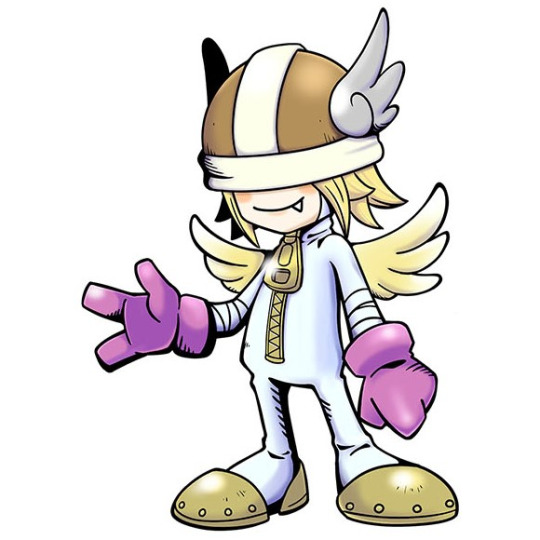
In the Adult/Champion level, we have Angemon. I believe it is the first angel Digimon in the franchise and the one on which all others are ultimately based. It is a being of virtue that brings happiness, though it is also relentless in the battle against evil. Each angel Digimon has a certain role in the angelic hierarchy and Angemon’s job is to lead other angelic Digimon in the fight against evil. It wields a quarterstaff called the holy rod. An Angemon who falls becomes a Devimon, which retains its role as a leader, it just leads evil Digimon instead of good ones. Angemon’s design is a classic and a great example of a Digimon that just looks like a human in a costume, but still feels different. Angemon is likely the most powerful of the Adult/Champion level angels and is often depicted as being far more powerful than its level would indicate. This is especially true in Digimon Adventure, where it was easily capable of beating Digimon a whole level higher than it.
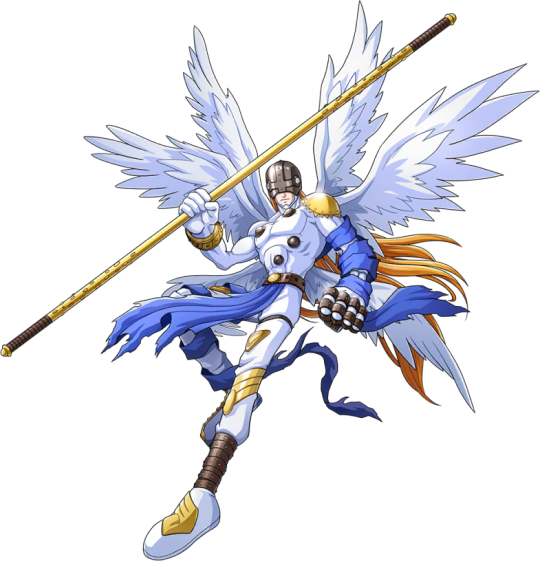
Pidmon is a variant of Angemon that ranks lower in the hierarchy, but is of similar power. Its design is a recolor of Angemon with a different staff and only one pair of wings. Many of the angel Digimon’s lore states that the number of wings an angel Digimon has indicates its rank in the hierarchy so the two-winged Pidmon ranks lower than the six-winged Angemon. This is not a hard and fast rule, as multiple angel Digimon have fewer wings than their rank would indicate. Pidmon’s role in the hierarchy is to destroy evil, presumably making it a major member of the forces that Angemon leads. Its name comes from Cupid, the Roman god of desire, attraction, affection, and erotic love. While a roman god seems like an odd inspiration for the very Christian-inspired angel Digimon, there could be a roundabout reference here. The winged baby statues that are often called cherubs are actually called putti and depict Cupid. Somewhere along the line some wires got crossed and the name of a rank of angel got applied to the putti statue.
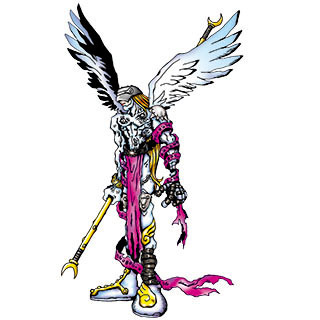
Darcmon is the last angel of this level and the fort one to appear feminine. Its four wings presumably place it between Pidmon and Angemon. It is heavily combat focused and takes the role of vanguard and advanced force in the angel army. Given their descriptions we can get an idea that in the angel army Pidmon make up the majority of soldiers, Darcmon are the advance fore that go straight to the front lines, and Angemon are the leaders. Darcmon is a reference to Jeanne D’Arc, better known to English speakers as Joan of Arc. She was a 15th century French military leader who claimed to receive visions from angels and saints. She was convicted of heresy and executed, but the Catholic church later revoked the conviction and declared her a saint. She referred to herself as la pucelle, the maiden, which became the name of one of Darcmon’s attacks. I think Darcmon is severely underutilized for how cool her design is as far as I know, she has two anime appearances, one of which wasn’t actually a Darcmon but a villain in disguise.
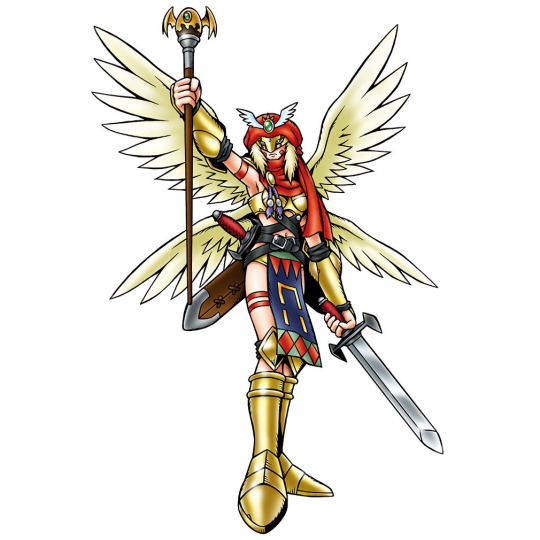
Luxmon, Pidmon, Darcmon, and Angemon are all classified as angel Digimon, which equates them to the lowest rung of the traditional hierarchy. Angel is used both to refer to the beings as a whole but also the lowest rank in the hierarchy. Their role it to act as announcers. They appear is scriptures to make various announcements, usually to humans.
The first angel Digimon of the Perfect/Ultimate level is HolyAngemon, renamed in English to MagnaAngemon. It has eight wings, placing it above Angemon. It has two forms: its regular form and HolyAngemon Priest Mode, which have different roles. Overall, HolyAngemon acts as the law enforcement of the angels, supervising and surveying the others to keep them within the bounds of their missions and try to catch any who fall. HolyAngemon Priest Mode is said to be the from it spends most of its time in. In this form, it spends its time acting as a spokesperson for God and goodness in general. When darkness arrives, it changes into its combat form to take up arms against evil. Ironically, despite Priest Mode being the form it’s supposed to spend most of its time in, this form is almost never seen in Digimon Media, being a long-time inmate of V-Tamer jail. HolyAngemon bears the sword Excalibur, an obvious reference to King Arthur.
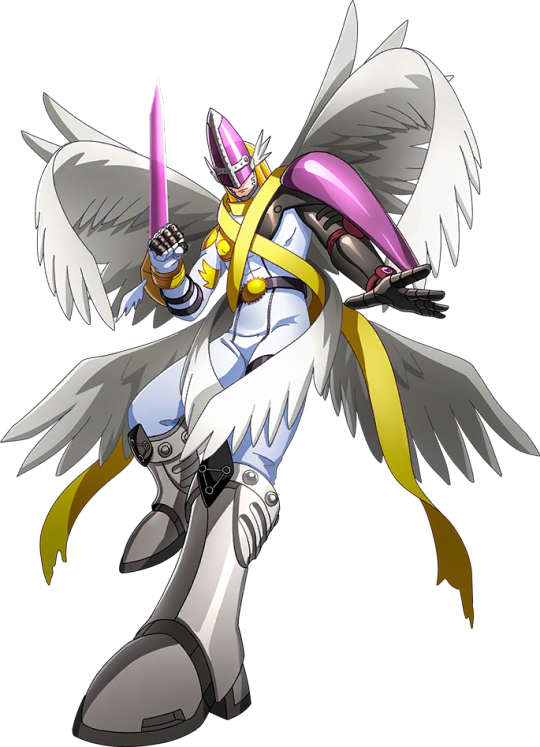
HolyAngemon
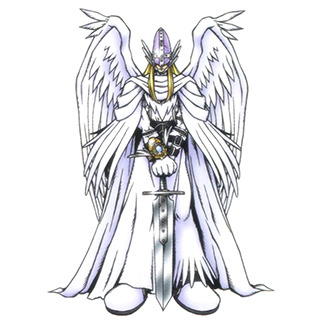
HolyAngemon Priest Mode
Next is Angewomon, who also has eight wings. She is a being of utmost beauty with an extremely kind personality. Her role is to try to redeem evil Digimon. By showing kindness and grace, she can bring Digimon back from the path of evil. However is a Digimon cannot be redeemed, she will attack and show that she is an extremely powerful combatant. She is often depicted as being equal in power to HolyAngemon A fallen Angewomon becomes a LadyDevimon, who is as cruel and wicked as Angewomon is kind and benevolent. The two species despise each other. Angewomon is one of the most popular Digimon for a very good reason. Her design is a classic and stands out among all the other “sexymon” designs out there. Angewomon has an x-antibody form which is fine. It’s overdesigned and unnecessary, but if that’s all I can say about an x-antibody form, it’s one of the good ones.
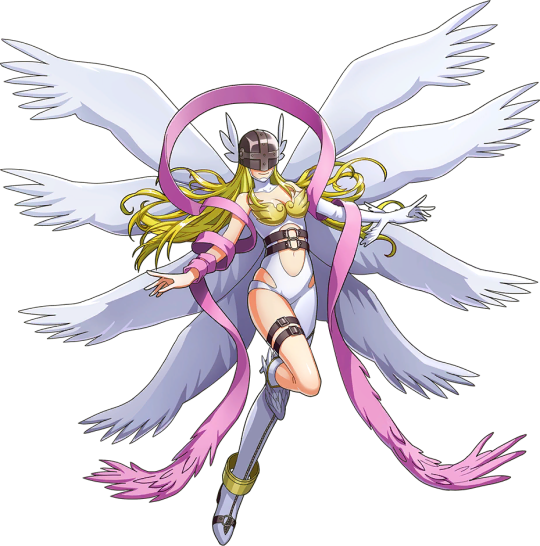
Angewomon
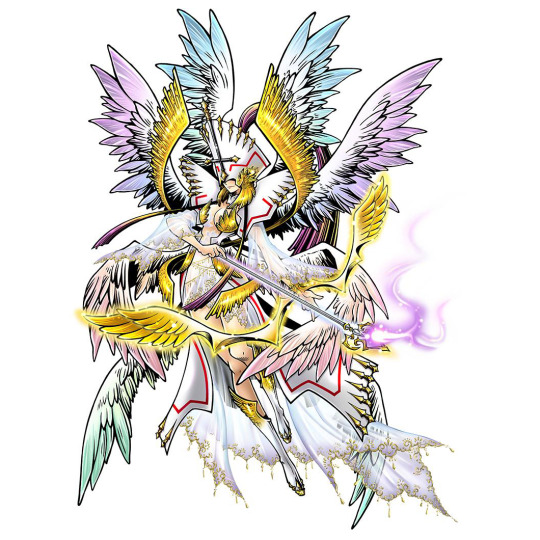
Angewomon X
HolyAngemon and Angewomon are both classified as archangel Digimon. Archangels are the second lowest in the hierarchy and their job is to make declarations. The idea of archangels being the highest rank of angel seems to come from the epic poem Paradise Lost and confusion over the name. “arch-“ means “chief” or “first” so people mistakenly assumed that the chief angels were the highest rank. Despite this, Michael (who is explicitly an archangel and the only one ever called that in the bible) is often seen as God’s second in command even by clerical sources, furthering the confusion. A very common idea is that there are four or seven archangels with different names and roles. Michael, Gabriel, and Raphael are almost always among their number, but the identities of the rest vary depending on tradition. Worth nothing is the Digimon Bagramon, a former archangel. He ruled over death in the Digital World before rebelling and falling. This would equate him to the angel of death, a figure who transports the souls of the dead to the afterlife and is usually named Azrael.
Also at the Perfect/Ultimate level is ArkhaiAngemon. It is of equal rank to HolyAngemon and Angewomon and does have eight wings. Unlike its fellows, ArkhaiAngemon is a more defensive and support fighter, allowing it to protect its subordinates and command them in battle using ingenious strategies. ArkhaiAngemon is driven by a concern for others, which leads it to interact with other Digimon more than its fellows. It frequently employs non-angel Digimon as familiars who fight on its behalf. It wields its own version of Angemon’s holy rod, which can release a flame that alternately harm and protect. While being of equal rank to HolyAngemon and Angewomon (and its name being a corruption of “archangel”), ArkhaiAngemon is identified as a principality, the rank above archangel. Their job is to guide and protect organizations, whether they be nations, groups of people, or other institutions. This fits with ArkhaiAngemon guiding and protecting its subordinates.
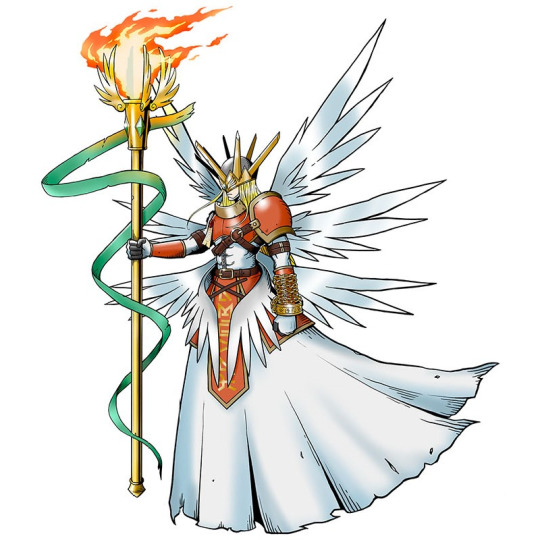
At the Ultimate/Mega level, we have SlashAngemon, a badass angel made of swords. It is the leader of the angel army and the ultimate military commander of the angel Digimon. It is stern and serious and cuts down evil without hesitation. It has 8 wings, but this is the level where the wings = rank thing starts breaking down.
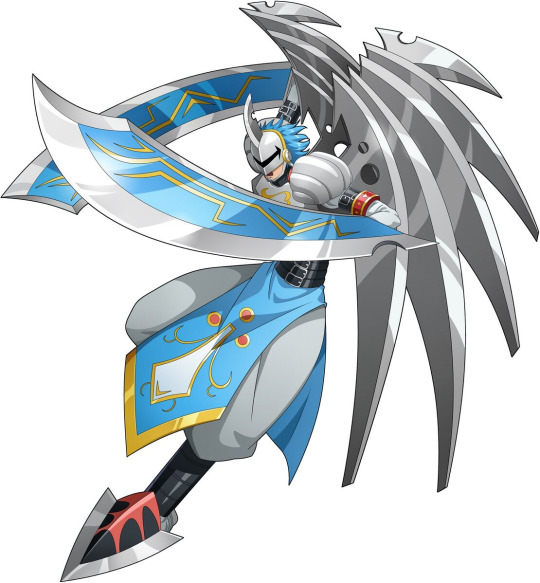
Another militant angel of this level is LovelyAngemon. She is a cheerful and fashionable angel whose cuteness and charm belies the fact that she is the foremost close combat expert amongst the angel Digimon. It has the data of multiple styles of martial arts within its code, making it a martial artist is extremely powerful punches. Interestingly, LovelyAngemon has no wings.
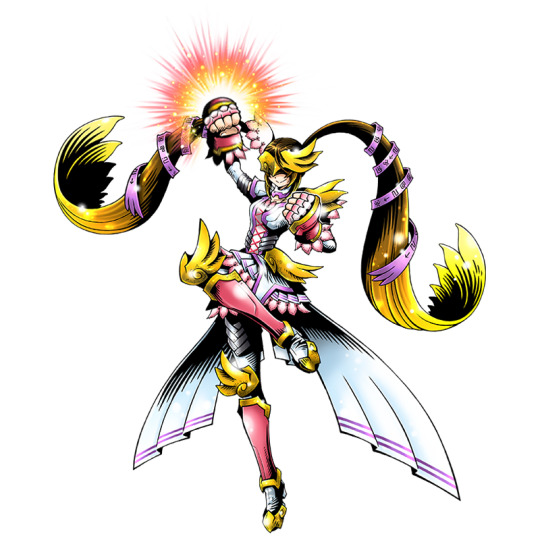
SlashAngemon is identified as a power, the rank of angel above principalities and the first of the second sphere. They are granted the power over evil forces, restraining demons from hurting humans. They also oversee human authorities such as kings. The power over evil thing fits SlashAngemon. As the leader of the angel army, it is the one who commands the fight against evil. LovelyAngemon is not identified with any rank of angel, but given she is a combat specialist, I would guess she’s heavily involved in the fight against evil and is therefore likely a power.
ClavisAngemon bears a key called the key (very original) which can unlock any lock in the Digital World. Only ClavisAngemon can use the key and it appears that the angel is part of the key rather than a separate being holding it. ClavisAngemon’s duty is to guard the zenith gate, the gate that separates the Digital World from realms beyond. As the kernel is in a higher dimension than the Digital World, it would seem that ClavisAngemon guards the passage to the kernel and only lets angel Digimon through. It can bring the entire power of the Digital World down on an enemy that tries to break through the gate. ClavisAngemon has six wings and is identified as a virtue, the rank above powers. Virtues are supposed to govern over the elements, bring natural events like storms and wind. They are also associated with movement and assist in creating miracles. There isn’t much of a connection to ClavisAngemon, but it may be related to another story. In the Adam and Eve story, after the two are ejected from the garden an angel is assigned to guard the entrance and prevent them from getting back in. That sounds more like ClavisAngemon’s role than anything else. Clavis is Latin for “key” so the Digimon named key carries a key named the key.
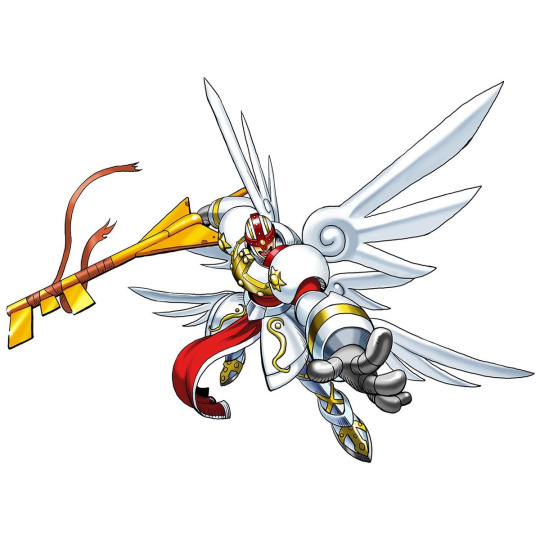
Next up is Dominimon and Games Workshop is looking at those pauldrons with envy and fear. It falls outside of the angelic chain of command and is a rare being that only appears when the balance between light and darkness is severely disrupted. Its purpose is protect other angel Digimon and destroy evil at all costs. It has no sense of self-preservation and will throw itself into deadly situations or use a special move to empower other angel Digimon at the cost of its own life without hesitation. Because of how rarely one appears and their self-destructive tendencies, very few have ever actually seen a Dominimon and many think they are mere legends. It wields the sword Final Excalibur, a powered-up version of HolyAngemon’s Excalibur. Despite falling outside of the angelic chain of command, Dominimon is identified as a dominion, the rank of angel above virtues and the last of the second sphere. Their purpose is to govern the motions of stars, planets, and other celestial objects. Not a whole lot of connection to Dominimon there. Dominimon has ten wings.
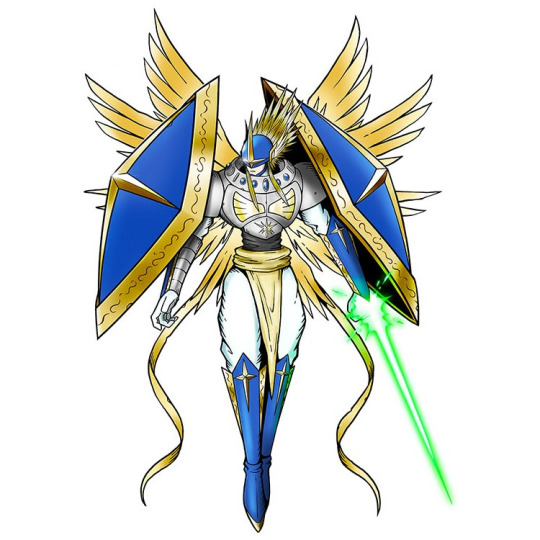
Another angel Digimon that doesn’t follow the normal chain of command is Mastemon. It is an anomaly that is a fusion of an Angewomon and her fallen counterpart LadyDevimon, making her a living enemies-to-lovers lesbian relationship unprecedented merging of light and darkness that only appeared when the Digital World faced a threat so great it forces angel and fallen angel Digimon to work together to stop it. While firmly benevolent, Mastemon commands both holy and evil powers and can command both angel and fallen angel Digimon. It is a master strategist and only it uniting the forces of good and evil saved the Digital World from that unspecified threat. Mastemon does not correspond to any mythical rank of angel and has 12 wings, half white and half black. This is a clear reference to Lucemon, who was the greatest of the angel Digimon before falling and becoming the greatest of all demon lords. Lucemon also has 12 wings that are half white and half black. In his case, this symbolizes him being trapped between his original benevolent self and his new evil self. Lucemon and Mastemon are both angelic being between good and evil, but Lucemon is malevolent while Mastemon is benevolent. I don’t think there’s been any media comparing the two, but it’s a great story idea. The name comes from Mastema, a demon or fallen archangel in some Jewish texts identified as a bringer of disaster and evil. I suppose there’s some connection with Mastemon only existing due to a disaster, but it’s tenuous.

This too is yuri
Rasielmon is the first angel Digimon to not just be a winged human. She’s still mostly human, but with some cat-like features. It once held the same rank as the more powerful Ofanimon, but no longer does for unknown reasons. Rasielmon resides within the kernel and has the power to foresee anything in the Digital World as long as it remains there. This makes it one of the most knowledgeable Digimon. It commands the godai, the five elements of Japanese Buddhism: earth, fire, water, wind, and void. Rasielmon also has an attack called Sefer Raziel, named after the Kaballah text Sefer Raziel HaMalakh. This text claims to teach magic and cites Raziel, angel of secrets and a teacher of wisdom, as the most powerful angel. Rasielmon being based on an angel associated with secrets and knowledge certainy fith with it being able to see the entire Digital World. If Rasielmon falls, she becomes Raguelmon. Raguelmon was shunned for its knowledge and became a nihilist. It still seems to care for angel Digimon in a twisted way as it can sense when an angel Digimon is close to falling and will try to prevent it by killing them first. Raguelmon is named after Raguel, an angel of justice who keeps demons in check. Raguelmon’s actions can certainty be seen as a twisted version of justice and preventing of evil.

Rasielmon
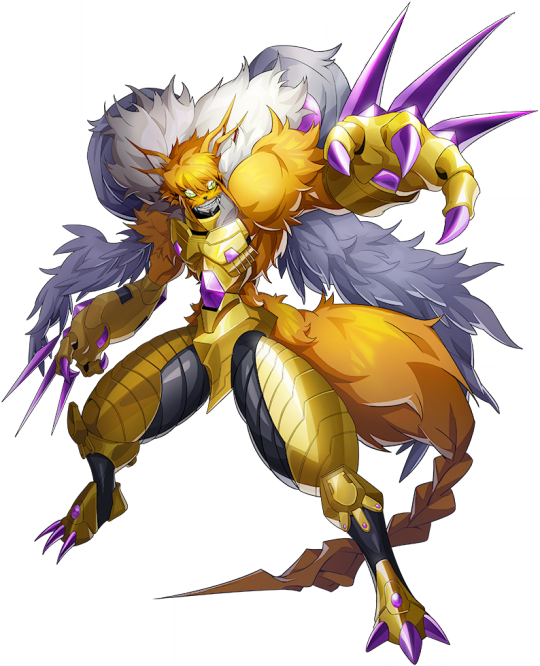
Raguelmon
We have reached the top, the zenith of the angelic Digimon, the Three Archangels. These three are the most powerful of all angel Digimon, charged with enacting God’s will and guarding the kernel from all who would threaten it. The first of the three is Ofanimon (English: Ophanimon). She is the ultimate form of feminine angel Digimon and her duty is to impart God’s love on the Digital World. It nurtures and protects other Digimon and wishes to see them do good, but it can and will fight against evil. It has 10 wings. Ofanimon has an x-antibody form which is pretty good as far as x-antibody forms go, but still overdesigned. If Ofanimon becomes enraged at the seemingly-endless amount of evil in the Digital World, it will become Ofanimon Falldown Mode. It has closed its heart and become a dark avenger, nipping evil in the bud by attacking Digimon with the potential to become evil. It seeks to establish a world of absolute justice where evil is destroyed before it has the chance to take root. An Ofanimon who falls even further will become Lilithmon.
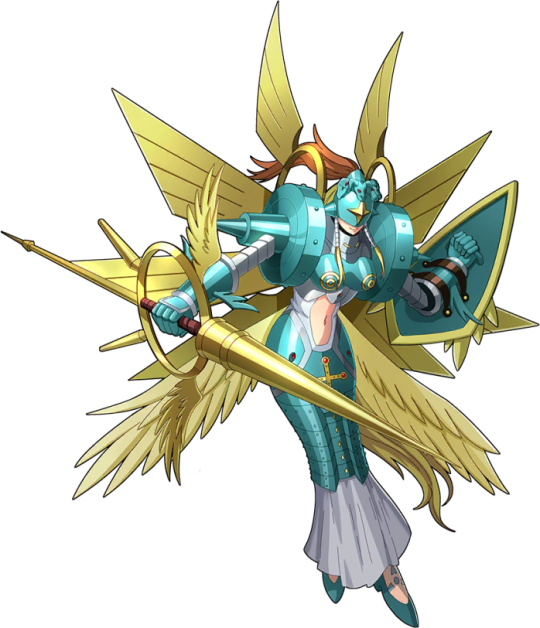
Ofanimon
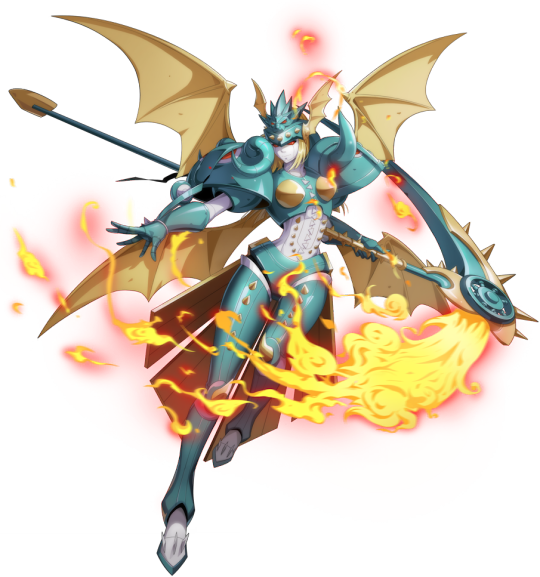
Ofanimon Falldown Mode Mommy? Sorry, mommy? Sorry, mommy?
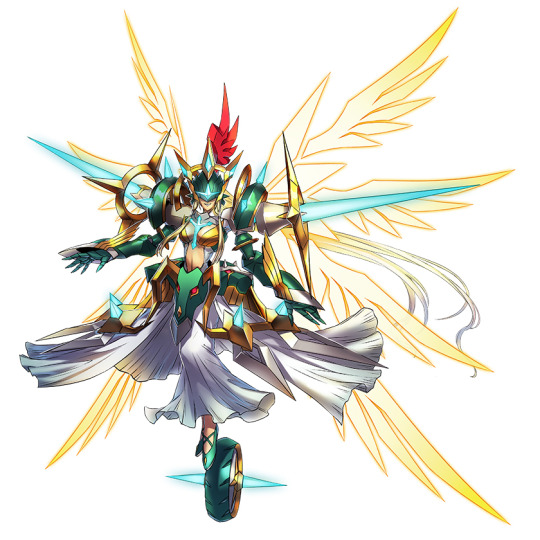
Ofanimon X
Rasielmon and Ofanimon are both classified as ophanim, the class of angel above dominions. Also called thrones, they serve either as the wheels of the throne of God, or the throne itself. They are also charged with chanting glorias and maintaining the harmony of universal laws. These guys are the classically weird biblically accurate angels. They are depicted as flaming wheels within wheels covered in eyes. The idea of gods having wheeled thrones was common in the ancient Middle East, with multiple cultures depicting their gods seated on such. Ofanimon bears no resemblance to a wheel, but her shoulder pads take the shape of wheels and Ofanimon X balances on a wheel.
Next is Cherubimon Virtue, which is the only fully non-human of the angel Digimon. It looks instead like a humanoid rabbit with no wings. It is the ultimate holy beast and its duty is to protect and impart God’s wisdom. Because Cherubimon Virtue stands at the zenith of divine virtue, it is easily stained by the inverse and can fall to become Cherubimon Vice, a thoroughly evil creature that embodies sin and wickedness just as its Virtue form embodies the opposite. Both forms can call down lightning as a form of divine judgement. Cehrubimon is based on the cherubim, the rank of angel above the ophanim. Their role is to accompany God when he travels. Cherubim are another bizarre-looking angel and while they don’t look like rabbits there is an association with animals that fits Cherubimon being a holy beast. Cherubim have four faces: a human, an ox (representing domesticated animals), a lion (representing wild animals), and an eagle (representing birds). They also have four wings, four arms, hooved legs, and are covered in eyes. Frankly, one of those would have been a lot cooler as a Digimon than a big rabbit. There is a reference to the faces of the cherubim, but it’s in Ofanimon not Cerubimon. Her helmet has the heads of the three animals on it. Both forms of Cherubimon have x-antibody variants which are classically x-antibody. That is not a compliment.

Cerubimon Virtue (left) and Vice (right)
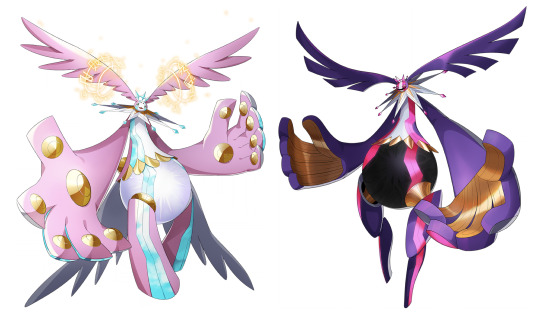
Cherubimon Virtue X (left) and Vice X (right)
The final angel Digimon is Seraphimon. It returns to the winged human design, but is entirely covered in armor and has 10 golden wings. It is the most powerful of the angels and the closest of all Digimon to God. As the highet-ranking angel, it is the one ultimately in charge of all others. It is also the ultimate masculine angel and its duty is to enforce Gods laws. Legends say that when the final battle between good and evil comes, Seraphimon will descend to the Digital World and purify everything. Its ultimate ability is to sacrifice its life to restart the world. If a Seraphimon becomes overwhelmed with resentment it will become a BlackSeraphimon (English name: ShadowSeraphimon). It is still redeemable in this state, but if not redeemed in time, it will fall and become a Demon (as in the Digimon named Demon, not just some demon). Seraphimon is based on the cherubim, the highest rank of angel in Christian Angelology. Their role is to stand around the throne of God chanting “holy, holy, holy” and are also charged with anointing. The word “seraph” means “burning” and was often used to describe snakes (possibly referencing the burning sensation of snake venom). As a result, seraphim are often depicted either as snakes or as being on fore or made of fire. All depictions give them six wings, which are sometimes used to cover their body to protect humans from seeing their power. Seraphimon covering its entire body with armor could be a reference to this. Seraphimon being the ultimate masculine Digimon to Ofanimon's ultimate feminine Digimon could be a reference to systems like Kabbalah and some forms of Gnosticism assigning different magical powers or holy virtues to males and females.
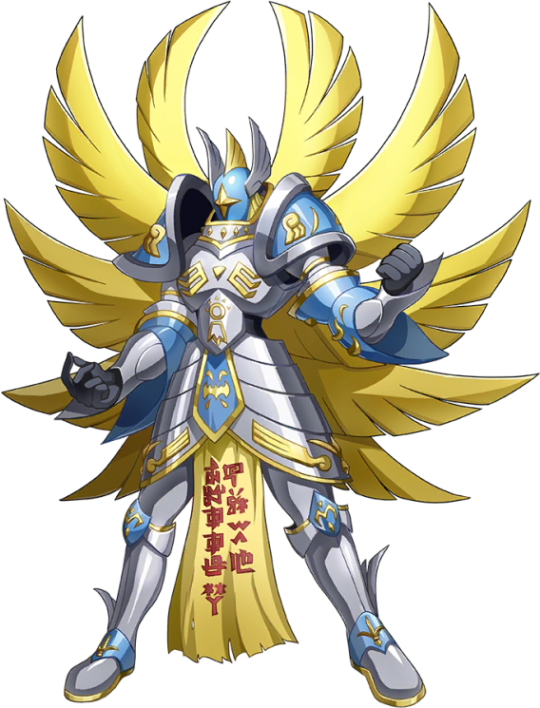
Seraphimon
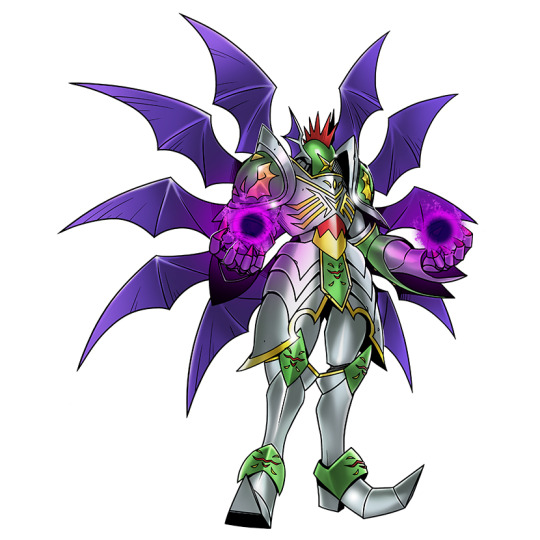
BlackSeraphimon
#digimon#mythology#christian mythology#jewish mythology#angelology#angel#archangel#luxmon#angemon#pidmon#darcmon#holyagemon#magnaangemon#angewomon#arkhaiangemon#slashangemon#clavisangemon#lovelyangemon#mastemon#dominimon#rasielmon#raguelmon#ofanimon#ophanimon#cherubimon#seraphimon#ofanimon falldown mode#blackseraphimon#shadowseraphimon
102 notes
·
View notes